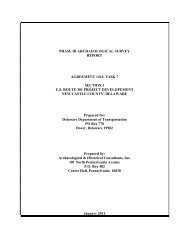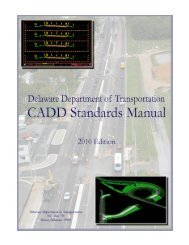Gulph Creek Stone Arch Bridge - Delaware Department of ...
Gulph Creek Stone Arch Bridge - Delaware Department of ...
Gulph Creek Stone Arch Bridge - Delaware Department of ...
Create successful ePaper yourself
Turn your PDF publications into a flip-book with our unique Google optimized e-Paper software.
Chapter 3—Historic Context for Common Historic <strong>Bridge</strong> Types<br />
establishment finally washed over Luten in 1918, and his patents, along with some <strong>of</strong><br />
Thacher’s, were invalidated.<br />
Despite his defeats, by 1919 Luten claimed to have designed at least 17,000<br />
bridges in all but three states. Although the actual number may be lower, it is certain that<br />
he did more than any other designer or builder to encourage the construction <strong>of</strong><br />
reinforced concrete arches by county and municipal governments, and hundreds <strong>of</strong> Luten<br />
designed bridges still exist across the country, although the largest groupings may be<br />
found in California, the states <strong>of</strong> the Midwest, and in the states along the Atlantic<br />
seaboard. The popularity <strong>of</strong> his design did not continue far beyond the first two decades<br />
<strong>of</strong> the twentieth century, however, due both to the patent issues and because his designs<br />
were simply not efficient in the use <strong>of</strong> steel and concrete. Other engineers eventually<br />
surpassed Luten in the area he thought most his own; the practical combination <strong>of</strong> theory<br />
and empirical practice.<br />
Significance Assessment: Thousands <strong>of</strong> Luten arches likely survive nationwide<br />
out <strong>of</strong> the 17,000 claimed to have been built during the 1910s and 1920s. They are<br />
characterized as having either open or closed spandrels, single and multiple rib or barrel<br />
arches <strong>of</strong> short to intermediate span (40 to 150 feet). However, since this describes most<br />
arch forms, documentation is needed to established whether a bridge is a Luten patented<br />
or designed example. Documentation includes bridge plaques, city and county records<br />
and comparison to known Luten bridges in state bridge surveys.<br />
Documented Luten arches with a high level <strong>of</strong> integrity, although quite common,<br />
are significant within the context <strong>of</strong> this study if they retain their character-defining<br />
features. Character-defining features include the arch ring, spandrels, ribs or barrel,<br />
railing or parapet, and abutments and wingwalls. Luten was an important promoter and<br />
builder <strong>of</strong> the reinforced concrete arch form in the early-20th century.<br />
Examples <strong>of</strong> Reinforced Concrete Luten <strong>Arch</strong><br />
1. Illinois River <strong>Bridge</strong> (1922), Benton County, AR. NRHP listed 1988 in<br />
Benton County MRA.<br />
2. Harp <strong>Creek</strong> <strong>Bridge</strong> (1928), Newton County, AR. NRHP listed 1990 in<br />
Historic <strong>Bridge</strong>s <strong>of</strong> Arkansas MPS.<br />
3. Andrew J. Sullivan <strong>Bridge</strong> (1928), Whitley County, KY. Determined<br />
NRHP eligible by SHPO.<br />
4. American Legion Memorial <strong>Bridge</strong> (1930), Grand Traverse County, MI.<br />
NRHP listed 2000 in Highway <strong>Bridge</strong>s <strong>of</strong> Michigan MPS.<br />
5. Andrew J. Sullivan <strong>Bridge</strong> (1928), spanning Cumberland River,<br />
Williamsburg vicinity, Whitley County, KY. HAER KY-51.<br />
6. Milwaukee Street <strong>Bridge</strong> (1930), spanning Rock River, Watertown,<br />
Jefferson County, WI. HAER WI-33.<br />
Figures 3-50 and 3-51 depict examples <strong>of</strong> Luten closed and open spandrel<br />
designs.<br />
3-59






